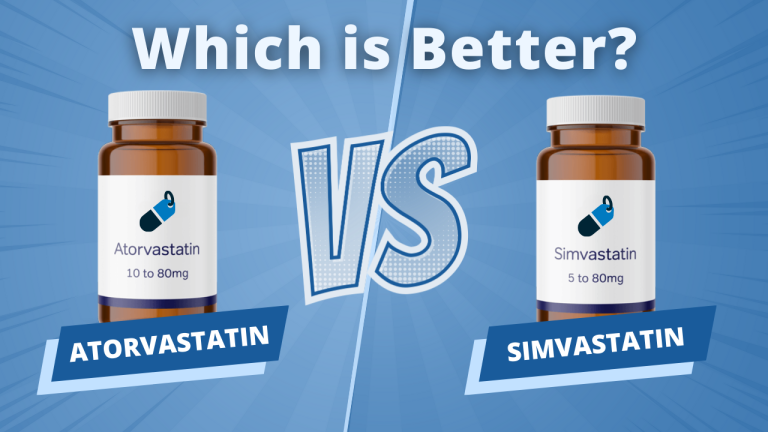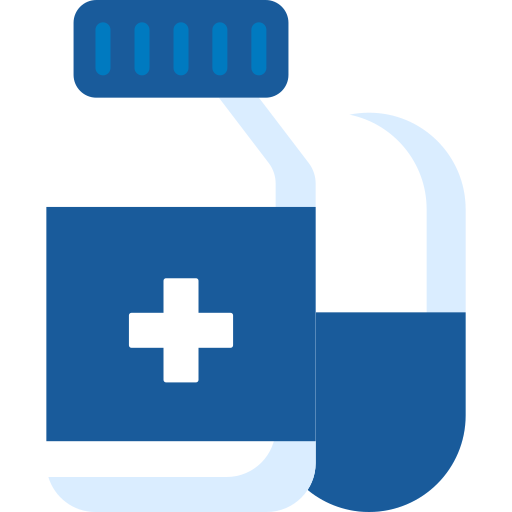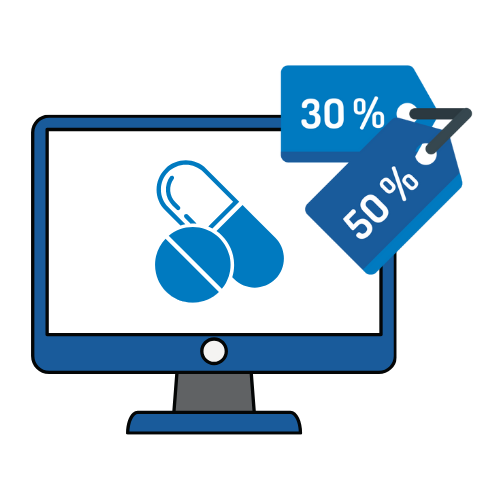Atorvastatin vs Simvastatin: Which Is Better?
- Last Updated: January 4th, 2024
Key takeaways:
Atorvastatin and Simvastatin are drugs known as statins that help lower bad cholesterol levels in the body.
Both drugs work well, but Atorvastatin is often more effective at reducing LDL cholesterol levels.
The dosage for these medications varies, with less Atorvastatin needed to achieve the same effects as Simvastatin.
Some common side effects from both drugs can include muscle pain, fatigue, upset stomach and diarrhea.
While deciding between the two medications, discuss your health condition and needs with a healthcare professional.
Atorvastatin vs Simvastatin: A Comprehensive Comparison
On this page, we’ll provide an in-depth comparison of Atorvastatin vs Simvastatin, discuss the nuances of these two popular statin drugs, analyze the effectiveness of each drug, and much more.

Intro to Atorvastatin and Simvastatin Cholesterol Drugs
Choosing the right medication to manage your cholesterol can be a daunting task.
With numerous options available, like Atorvastatin and Simvastatin, it becomes challenging to decide which one is more effective.
Let’s start this health journey together and discover which drug might be a better fit for you!
Table of Contents
What are Atorvastatin and Simvastatin?
Atorvastatin and Simvastatin are both types of statins, a class of medications known as HMG CoA reductase inhibitors that work to lower cholesterol levels by blocking the enzyme in your liver that produces cholesterol.
Types of statins
Statins, also known as HMG CoA reductase inhibitors, are a class of drugs primarily used to lower cholesterol levels in the body.
They work by inhibiting an enzyme in the liver that is responsible for producing cholesterol.
Here’s a list of various types of statins:
- Atorvastatin: This is a high-intensity statin known for its potency and efficacy in lowering LDL (bad) cholesterol levels. Atorvastatin can reduce LDL cholesterol by up to 50 percent or more.
- Simvastatin: Although less potent than atorvastatin, simvastatin still effectively decreases LDL cholesterol levels.
- Pravastatin: Belonging to the group of low-intensity statins, pravastatin offers beneficial lipid-lowering effects with fewer risks of adverse side effects.
- Rosuvastatin: This is another high-intensity statin that can significantly reduce LDL cholesterol levels, much like atorvastatin.
- Fluvastatin: A less common type of statin, fluvastatin is nevertheless effective in treating high cholesterol levels.
- Lovastatin: Often prescribed as an initial treatment option for high cholesterol, lovastatin provides good results with minimal side effects.
- Pitavastatin: The newest addition to the family of statins, pitavastatin shows potential promise for treating patients with high cholesterol who do not respond well to other types of statins.
How they work to lower cholesterol
Atorvastatin and simvastatin are both classified as ‘statins,’ a type of drug that works to reduce cholesterol levels in the body.
Their operation hinges on their ability to block an essential substance your body needs for producing cholesterol, specifically known as HMG-CoA reductase.
By inhibiting this enzyme, these statins halt the production process of cholesterol within the liver.
This biochemical intervention results in a considerable decrease in LDL – or “bad” – cholesterol, contributing to overall lower blood cholesterol levels.
Significantly reducing LDL-cholesterol is crucial since high levels can lead to harmful plaque buildup in arteries—a primary factor behind heart disease and strokes.
Atorvastatin has shown greater potency than simvastatin when it comes to curbing LDL-cholesterol levels.
It’s all part of how these two drugs work efficiently towards maintaining healthy lipid profiles and promoting cardiovascular health.
Differences Between Atorvastatin and Simvastatin
While both Atorvastatin and Simvastatin belong to the same family of cholesterol-lowering drugs known as statins, they differ significantly in terms of potency, dosage requirements, overall effectiveness in lowering LDL cholesterol levels, availability, and cost.
Potency
Atorvastatin packs a more potent punch than simvastatin in the battle against high cholesterol.
Known to be an effective soldier against severe hyperlipidemia, atorvastatin’s strength lies in its extensive reach and capability.
Evidence suggests that a 10 mg dose of this statin can outperform a 20 mg dose of simvastatin when tasked with treating primary hypercholesterolemia.
This difference underlines atorvastatin’s stronger ability to reduce LDL cholesterol levels and fight off heart disease risks compared to simvastatin.
It is crucial to understand this potency factor while choosing between these two statin medications for managing your high cholesterol levels.
LDL Cholesterol Dosage
Physicians typically prescribe atorvastatin and simvastatin to lower cholesterol levels in individuals with high cholesterol.
While the drugs perform similar roles, their dosages vary significantly.
For instance, a 10-20mg dose of atorvastatin has shown greater efficacy in reducing LDL cholesterol than a 20-40 mg dose of simvastatin.
Furthermore, controlled dosing studies indicate that 40 mg of simvastatin matches the effectiveness of either a 10 or 20 mg dose of atorvastatin.
The dosage adjustment aims for optimal results while minimizing side effects associated with these statin drugs such as muscle pain and liver disease.
Always follow suitable medical supervision when taking either medication to ensure safety and effectiveness throughout your treatment period.
Effectiveness
Atorvastatin often prevails over Simvastatin in terms of effectiveness, especially for individuals suffering from familial hypercholesterolemia.
This potent statin consistently achieves treatment targets, demonstrating its powerful cholesterol-lowering abilities.
Demonstrable evidence supports this claim as well with a study showing that just 10 mg of Atorvastatin surpasses the efficacy of 20 mg of Simvastatin in combatting primary hypercholesterolemia.
Through rigorous patient trials and examination, it emerges clearly that the key difference between these two rivals lies in their potency to lower cholesterol.
The superiority of Atorvastatin’s cholesterol-lowering prowess seals its position as a preferred option for many battling high LDL (low-density lipoprotein) levels.
Supporting this are consistent findings indicating enhanced results with Atorvastatin even at lower doses when compared to higher doses of Simvastatin.
Availability and cost
Getting your hands on atorvastatin and simvastatin is relatively easy as they are widely available generic drugs.
However, price differences do exist between the two.
Simvastatin tends to be less expensive with prices hovering around $10-15.
Atorvastatin comes with a slightly higher price tag, but its costs often offset by related reductions in medical service and indirect expenses.
So, while upfront costs might seem higher for atorvastatin, consider long-term savings in healthcare expenditure when making a choice between the two medications.
Atorvastatin vs Simvastatin: Which is More Effective for Lowering Cholesterol?
Atorvastatin and Simvastatin both demonstrate effectiveness in lowering cholesterol, but research indicates differences between their impacts on LDL, HDL, and overall cardiovascular risk.
Discover more about these comprehensive studies to make an informed decision for your health.
Results from clinical studies
Clinical studies provide a wealth of insight into the effectiveness of Atorvastatin and Simvastatin in treating high cholesterol.
Research has shown these medications, known as statins, to be successful in significantly decreasing cholesterol levels and reducing the risk of coronary heart disease.
A meta-analysis revealed that both Atorvastatin and Simvastatin were effective at lowering LDL cholesterol, commonly referred to as ‘bad’ cholesterol.
However, expert findings from Stanford Medicine imply that statin use can benefit cardiovascular health beyond merely managing cholesterol levels.
On comparing different types of statins, Rosuvastatin stands out for reducing LDL by 8.2% more than Atorvastatin.
While every individual’s response to medication varies, comprehensive clinical trials confirm the potential benefits and effectiveness of both drugs in managing high blood cholesterol.
Target populations: Increased risk
Statins like Atorvastatin and Simvastatin specifically target populations with high cholesterol levels.
People suffering from conditions such as coronary heart disease or those at an increased risk of cardiovascular disease can greatly benefit from these medications.
Clinical studies have shown that statin therapy is highly effective in reducing LDL (low-density lipoprotein) cholesterol, colloquially known as ‘bad’ cholesterol.
Moreover, individuals with a family history of high cholesterol or heart disease are recommended to start statin treatment early.
Regular consumption prescribed by the healthcare professional helps decrease cholesterol levels, preventing the accumulation in blood vessels.
Hence, people prone to strokes and liver diseases also fall within this target population group due to the proven capacity of statins to avert these health risks.
- Hence, people prone to strokes and liver diseases also fall within this target population group due to the proven capacity of statins to avert these health risks.
- Hence, people prone to strokes and liver diseases also fall within this target population group due to the proven capacity of statins to avert these health risks.
- Hence, people prone to strokes and liver diseases also fall within this target population group due to the proven capacity of statins to avert these health risks.
- Hence, people prone to strokes and liver diseases also fall within this target population group due to the proven capacity of statins to avert these health risks.
- Hence, people prone to strokes and liver diseases also fall within this target population group due to the proven capacity of statins to avert these health risks.
Side Effects of Atorvastatin and Simvastatin
Despite their benefits in lowering cholesterol, both Atorvastatin and Simvastatin can cause several side effects such as muscle pain, fatigue, and upset stomach among others which we’ll delve into further.
To better understand these potential risks and find a suitable statin for your needs, continue reading.
Muscle pain
Muscle pain, an oft-cited side effect of both Atorvastatin and Simvastatin, may actually not be as universally severe as commonly believed.
Statin-related muscle discomfort often manifests as cramping, soreness, or weakness, though the severity ranges from mild to significantly debilitating in rare instances.
Contrary to popular perception, over 90% of statin users do not report these symptoms explicitly linked to the medication.
The highest risk of muscle pain is associated with Simvastatin when compared to other statins on the market.
This therapy-induced discomfort remains a relatively misunderstood phenomenon, warranting further scientific investigation for more definitive conclusions.
It’s crucial that patients experiencing new or exacerbated muscle pain whilst on these medications discuss their symptoms promptly with a healthcare professional to determine whether it’s linked to their treatment regimen and how best it can be managed.
Fatigue
Statin medications, such as Atorvastatin and Simvastatin, can sometimes lead to feelings of fatigue.
This side effect presents itself as reduced energy levels or increased tiredness, particularly during physical activities.
Patients taking these drugs have reported this type of exertional intolerance.
It’s important for individuals with high cholesterol to be aware that up to 4% of statin users may experience these effects and should consider discussing potential solutions or alternatives with their healthcare professional if fatigue becomes a significant concern.
Fatigue shouldn’t be seen as an inevitable consequence of medication but rather an indication of possible adjustments in the treatment plan through dialogue with your physician.
Upset stomach and diarrhea
Experiencing an upset stomach and diarrhea is a common occurrence with the use of Atorvastatin and Simvastatin, two commonly prescribed statin medications.
These side effects can be mild for some but may disrupt daily activities in others.
Alterations in diet or medication dosage might help mitigate these symptoms, promoting more comfortable treatment experiences.
Further instances of intestinal disturbance like abdominal cramping or bloating may accompany these symptoms as well.
Maintaining proper hydration during bouts of diarrhea is essential to avoid additional health complications.
If these side effects persist or become severe, it’s crucial to seek medical consultation without delay to ensure your safety while taking this medication.
Liver and kidney disease
Statins, such as Atorvastatin and Simvastatin, can sometimes affect the health of your liver and kidneys.
Although it’s rare, these medications may cause an increase in your liver enzymes.
If this elevation reaches three times the upper limit of normal, doctors usually advise stopping or switching statin therapy.
Furthermore, a severe side effect called rhabdomyolysis can result in kidney failure by causing muscle breakdown that leads to harmful protein accumulation in the bloodstream.
However, statins are generally safe for most people when taken correctly under medical supervision.
It is strongly advised not to take statins if you have active liver disease or decreased liver function due to their potential impacts on this organ.
Periodic blood tests might be required to monitor your liver function while you are taking these drugs.
Cardiovascular Disease Stroke
Strokes can occur when cholesterol build-up in the arteries results in a lack of blood flow to the brain.
Both Atorvastatin and Simvastatin help reduce this likelihood by lowering high cholesterol levels, therefore reducing obstruction in your blood vessels.
Interestingly, studies have revealed that Atorvastatin specifically aids recovery after a stroke by promoting angiogenesis or new blood vessel formation.
This contributes to functional improvement post-stroke as better vascular networks enhance nutrient supply to affected areas.
Moreover, statistics show that patients on statin therapy like Atorvastatin or Simvastatin experience lower stroke rates compared to those not using these drugs proving their effectiveness in stroke prevention.
Despite concerns around side effects associated with statins, it’s worth noting that the risk is minimal and generally safe for preventing strokes.
With CouponPharm’s discount offer for Atorvastatin now available online, managing your cholesterol levels has become more accessible and affordable.
High blood sugar and diabetes
Statins, including Atorvastatin and Simvastatin, are well-known for their cholesterol-lowering potential.
But they also have an unexpected side effect: they can increase your blood sugar levels.
This situation poses a unique problem.
On one hand, these drugs reduce the risk of heart disease by controlling cholesterol levels — on the other hand, higher blood sugar could potentially drive you into the range of prediabetes or even type 2 diabetes over time.
Clinical evidence suggests that statin users might face a moderate increase in their diabetes risk.
This link emphasizes the need for close monitoring of blood sugar in patients taking these medications to ensure early detection and management of any changes toward diabetes development.
Potential Interactions with Other Drugs
Both Atorvastatin and Simvastatin have the potential to interact with other medications.
This interaction can influence how these drugs are absorbed, distributed, metabolized, or excreted by your body, which will subsequently affect their efficacy in lowering cholesterol levels.
For instance, these statins may interact with Amiodarone, a medication used for heart rhythm problems.
Another significant interaction is with grapefruit products; consuming grapefruit while on these statins could increase the level of the medicine in your bloodstream and heighten the risk of side effects.
These drug interactions call for careful consideration when deciding on statin therapy as they can enhance the possibility of adverse effects such as muscle pain and liver damage.
It’s advisable to manage clinically relevant drug-drug interactions either by adjusting the dosage or opting for alternative treatments under professional medical guidance.
Safety Profiles of Atorvastatin and Simvastatin
Atorvastatin and Simvastatin are both notable for their generally well-tolerated safety profiles.
First, we consider the muscle toxicity that can occur with statin use, which may lead to discomfort or pain.
It’s important to consult your doctor if you experience any new or increasing muscle pain while on these medications.
Second, there’s a risk of elevated liver enzymes indicating potential liver damage. Routine tests can help monitor this aspect.
Analyzing a multicenter study on numerous patients shows no substantial differences in safety between Atorvastatin and Simvastatin.
It should be noted that Atorvastatin has proven more effective than its counterparts in managing hyperlipidemia, lending credence to its safe application at correct doses.
Lastly, contrary to some fears, no definitive evidence links the usage of statins like Atorvastatin or Simvastatin with cancer development, cataract growths, cognitive dysfunction progression, or peripheral neuropathy complications among other serious adverse effects.
Remembering all these facts is crucial when understanding how safe it might be for you to take Atorvastatin or Simvastatin as part of your cholesterol management strategy!
However, always remember each person reacts differently and ongoing consultation with your healthcare professional is key for optimal treatment outcomes.
Serious Adverse Events
Statins, including Atorvastatin and Simvastatin, have been linked with certain severe adverse events that may be of concern.
Although these serious side effects are rare, it’s crucial to understand them:
- Cancer: There is currently no strong evidence suggesting a direct link between statin use and cancer development.
- Cataracts: Some studies suggest a correlation, however, it remains an inconclusive theory.
- Cognitive Dysfunction: Despite minor reports of memory loss or confusion associated with statins, important safety label changes underline the temporary and non-severe nature of these cognitive side effects.
- Peripheral Neuropathy: This condition involves damage to the nerves outside of your brain and spinal cord; while connected to statin use in some cases, such instances are rare.
- Liver Damage: While both Atorvastatin and Simvastatin can cause liver damage in rare cases, routine monitoring helps avoid any serious implications.
- Muscle Pain: Statins can give rise to muscle pain as per multiple findings; nevertheless, health professionals recommend reporting any new pain immediately.
- Diabetes: While there is an association between high-dose statin use and increased risk of diabetes, the benefits typically outweigh this risk.
Atorvastatin vs Simvastatin: Which Statin is Better for You?
While the decision ultimately depends on your unique health history, risk factors, and consultation with a healthcare professional, utilizing our Atorvastatin coupon could help you manage high cholesterol levels cost-effectively.
Considering medical history and risk factors
Taking into account your medical history and risk factors is crucial when deciding on the right statin for you.
Here’s why:
- Statins can potentially interact with other medications you might be taking. These may include medications for heart disease, high blood pressure, diabetes, HIV/AIDS, depression, seizures, and even some types of cancers.
- It’s vital to disclose if you’ve had liver or kidney disease. Both Atorvastatin and Simvastatin can sometimes cause damage to these organs.
- A family history of heart disease or stroke plays a major role in determining which statin might be more beneficial for you.
- If you’re pregnant, planning to become pregnant, or are breastfeeding, it’s important to note that statins are not usually recommended as they may harm the baby.
- Age matters too. Older adults might be at a higher risk of muscle pain caused by statins.
- Lifestyle factors such as alcohol consumption and diet should also be taken into consideration while choosing a statin therapy.
- High blood cholesterol levels can greatly increase the risk of cardiovascular diseases such as heart attack or stroke – especially in individuals with other significant health risks like obesity or smoking habits.
Consultation with a healthcare professional
Seeking advice from a healthcare professional is vital before starting any statin therapy.
These professionals possess the skills and knowledge to evaluate your medical history, assess your risk factors, and gauge the potential benefits or downsides of commencing treatment with either atorvastatin or simvastatin.
They can also provide valuable insights into dosage instructions and possible side effects of these medications.
In-depth discussions allow them to design a treatment plan that best suits you, balancing effectiveness against potential risks.
Regular follow-ups ensure optimal control over cholesterol levels while minimizing adverse effects over time.
Atorvastatin vs Simvastatin: Conclusion & Recommendation
After weighing all facts, the choice between Atorvastatin and Simvastatin mostly depends on individual health conditions and needs.
One must discuss with a healthcare professional to select the right statin for effective cholesterol management.
Frequently Asked Questions
-
What is the difference between Atorvastatin compared to Simvastatin?
Atorvastatin and simvastatin are both medications used to treat high cholesterol, but they differ in terms of their effectiveness in lowering bad (LDL) cholesterol and increasing good (HDL) cholesterol.
- Atorvastatin and simvastatin are both medications used to treat high cholesterol, but they differ in terms of their effectiveness in lowering bad (LDL) cholesterol and increasing good (HDL) cholesterol.
- Atorvastatin and simvastatin are both medications used to treat high cholesterol, but they differ in terms of their effectiveness in lowering bad (LDL) cholesterol and increasing good (HDL) cholesterol.
- Atorvastatin and simvastatin are both medications used to treat high cholesterol, but they differ in terms of their effectiveness in lowering bad (LDL) cholesterol and increasing good (HDL) cholesterol.
-
Which one can cause kidney problems: Atorvastatin or Simvastatin?
Both Atorvastatin and Simvastatin have been known to contribute to kidney problems when taken at the highest dose for an extended period, but each individual’s reaction differs based on overall health conditions.
- Hence, people prone to strokes and liver diseases also fall within this target population group due to the proven capacity of statins to avert these health risks.
- Hence, people prone to strokes and liver diseases also fall within this target population group due to the proven capacity of statins to avert these health risks.
- Hence, people prone to strokes and liver diseases also fall within this target population group due to the proven capacity of statins to avert these health risks.
- Hence, people prone to strokes and liver diseases also fall within this target population group due to the proven capacity of statins to avert these health risks.
-
Can I take either medication with grapefruit juice?
Taking these medicines with grapefruit juice could potentially increase blood levels of these drugs, leading to a significant increase in side effects like kidney issues.
-
How soon can I see changes in my cholesterol levels after starting this medication?
You may start noticing a change in your LDL levels within a few weeks of using either generic simvastatin or Lipitor (generic name-atorvastatin), while it takes longer for HDL levels (high-density lipoprotein), commonly identified as ‘good’ cholesterol, to improve.
-
Is there any study comparing which one is better?
A study published by JAMA Internal Medicine has found that high-dose atorvastatin showed a significantly greater reduction in bad cholesterol compared to high-dose simvastatin.

Dr. Pharm
Pharmaceutical Drug Discount Expert


Determine your specific dosage and quantity needs to discover impressive savings opportunities.

Select from a range of available coupons for immediate use, or explore additional savings at various local pharmacies.

Simply present your chosen coupon, either in print or digital form, to your pharmacist when you collect your medication.
Coupon Pharm works relentlessly to gather prices, coupons, and savings tips for prescriptions at virtually every U.S. pharmacy to help you fight against high drug prices, price gouging and an out-of-control health care system.
Bottom line: Coupon Pharm offers unbiased price and coupon information to help you compare and save the most money on your prescriptions whether it’s with our coupons or a pharmacy’s already low retail price.
Nobody else does that!
Get Atorvastatin for as low as $7.25, which is 89% off the average retail price of $67.84 for the most common version, by using a Coupon Pharm discount card.
Get Adderall for as low as $10.50, which is 79% off the average retail price of $50.60 for the most common version, by using a Coupon Pharm discount card.
Get Lisinopril for as low as $4.36, which is 74% off the average retail price of $16.46 for the most common version, by using a Coupon Pharm discount card.
Get Metformin for as low as $4.33, which is 69% off the average retail price of $13.79 for the most common version, by using a Coupon Pharm discount card.
Get Hydrocodone for as low as $12.23, which is 89% off the average retail price of $100.03 for the most common version, by using a Coupon Pharm discount card.


Determine your specific dosage and quantity needs to discover impressive savings opportunities.

Select from a range of available coupons for immediate use, or explore additional savings at various local pharmacies.

Simply present your chosen coupon, either in print or digital form, to your pharmacist when you collect your medication.
